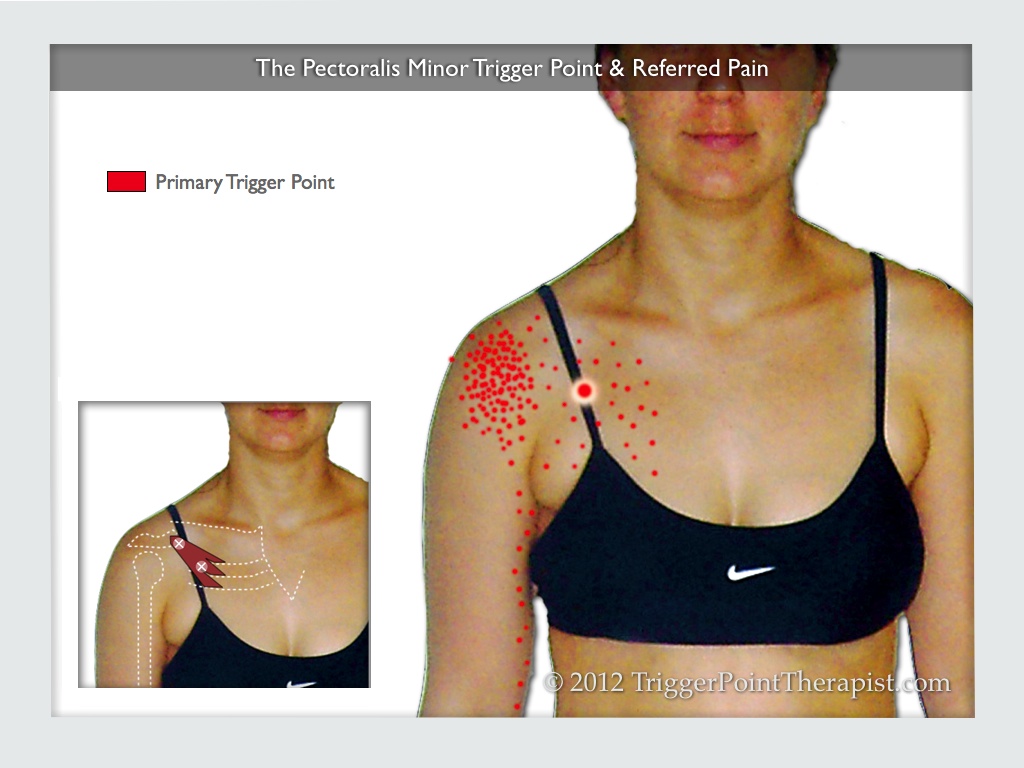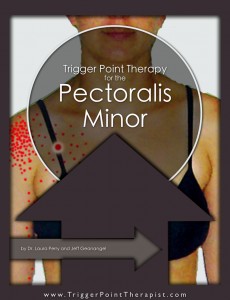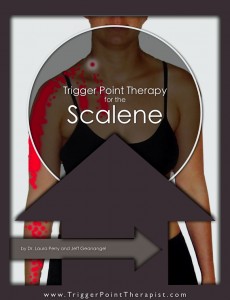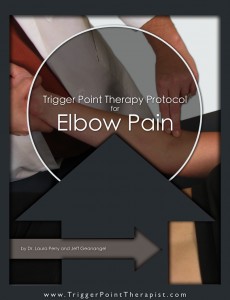Clinically speaking, the pectoralis minor muscle is the little brother of the pectoralis major muscle. Like all little brothers, the pectoralis minor wants to do everything that big brother does, so it’s no surprise that trigger points in these two muscles have almost identical referred pain patterns.
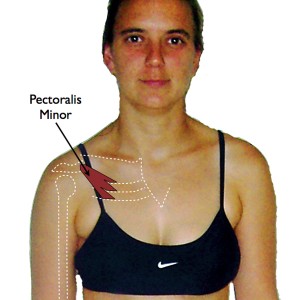 These pain patterns start in the front of shoulder and can extend down the inside of the arm, elbow, forearm, palm of the hand, and into the pinky, ring, and middle fingers.
These pain patterns start in the front of shoulder and can extend down the inside of the arm, elbow, forearm, palm of the hand, and into the pinky, ring, and middle fingers.
Not to be outdone by big brother, a tense pectoralis minor muscle can also entrap nerves in the armpit region that cause pain, numbness, and tingling to travel down the arm and into the hand.
As a therapist, I can tell you that you are never going to find this annoying little brother trigger point on his own. No, he is always going to be in the center of a whole family of trigger points that you are going to have to deal with too.
Oh brother.
The Pectoralis Minor Muscle
Location: The pectoralis minor is a small, thick muscle that lies in the chest region near the shoulder, underneath the larger pectoralis major muscle.
Function: This muscle functions to stabilize the shoulder girdle against the rib cage during downward thrusting movements of the arm, like when using crutches, chopping wood, or raising oneself out of a pool with your arms.
Muscle Attachments & Structure: The pectoralis minor originates on the coracoid process on the front of the scapula (shoulder blade) and splits into three sections that travel diagonally downward and medial to attach to the 3rd, 4th, and 5th ribs.
The skeletal landmarks and muscular attachments of this muscle are shown in Pectoralis Minor Pain and Trigger Points Video Excerpt.
Muscle Actions: Contraction of the pectoralis muscle pulls the shoulder blade downward (depression) and forward (protraction) on the ribcage. Conversely, if the shoulder is held in place by the levator scapula and trapezius muscles, contraction of the pectoralis minor can elevate the upper ribcage and assist in inhalation.
Biomechanical Considerations: Chronic tension in the pectoralis minor can produce “winging of the scapula” in which the vertebral edge and lower tip of the scapula stick out from the rib cage and become visually prominent.
Tension in this muscle can also cause it to compress (entrap) the nerves of the brachial plexus in the shoulder region, producing neurogenic pain and numbness that is experienced in the forearm, hand, and fingers. It may also restrict blood flow to arm by compressing the axillary artery. Because of these entrapments, trigger point activity in this muscle can be a major contributor to thoracic outlet syndrome (along with scalene trigger points).
The Pectoralis Minor Trigger Point
As shown in the diagram below, there is one primary trigger point in the pectoralis minor, though if trigger point activity in this muscle is intense, a second trigger point may also develop near the muscle’s attachment on the coracoid process.
I typically do not address the attachment trigger point in this muscle, if present, because it tends to spontaneously resolve itself when the primary trigger point is treated.
Pectoralis Minor Muscle Pain
The diagram also shows the referred pain pattern associated with the primary trigger point. The pain concentrates in the anterior shoulder region, though it may also extend across the chest. It will also frequently travel down the inside the upper arm, elbow, forearm (on the pinky side), palm, and into the pinky, ring and middle fingers.
This pain pattern is almost identical to that produced by the trigger points in the clavicular division of the pectoralis major.
Pectoralis Minor Symptoms & Disorders
Clients with an active pectoralis minor trigger point will present with any or all of the following symptoms or clinical findings:
- Pain in the anterior shoulder region, extending into the chest region when severe.
- Pain that travels down the inside of the arm to the pinky, ring, and middle fingers.
- Like with the pectoralis major trigger points, if this pain is experienced in the left shoulder, chest, and arm, it can be confused with the pain from heart disease or a heart attack.
- Pain on the inside aspect of the elbow, that mimics the pain of medial epicondylitis or “golfer’s elbow”
- Numbness or tingling in the forearm, hand, and fingers, like that associated with carpal tunnel syndrome and/or thoracic outlet syndrome.
- A weak or absent pulse at the wrist of the affected arm.
- Difficulty in reaching forward and up with the affected arm.
- A depressed shoulder girdle combined with winging of the scapula on the affected side.
What Causes Pectoralis Minor Trigger Points?
The following events or activities may activate or reactivate the pectoralis minor trigger points:
- Trauma to the chest from a car accident
- Whiplash from a car accident
- Fracture or bruising of the upper ribs
- Prolonged use of crutches
- Hyperventilation or heavy breathing
- Emotional or mental stress
- Carrying a heavy backpack or purse over the shoulder
- The head-forward, sunken-chest posture that is common in people that work at computers for long periods.
- Previous or intermittent cardiac pain from a heart attack or angina pectoris.
Related Disorders
- Thoracic Outlet Syndrome
- Medial Epicondylitis or “Golfer’s Elbow”
- Carpal Tunnel Syndrome
- Cervical Radiculopathy or herniated disk
- Cardiac Pain
Treatment of Pectoralis Minor Trigger Points
Important Note to the Reader: If you, or a client, is experiencing left sided shoulder and arm pain, it is imperative that a examination by a cardiologist be done immediately. Trigger point referred pain from the pectoralis muscles may occur secondarily to underlying heart disease, which must be ruled out or treated before trigger point therapy is indicated.
For more information on the pectoralis minor trigger point, including step-by-step instructions for releasing it, please watch the free Pectoralis Minor Trigger Point video by clicking on the image below.
Related Articles:
- Pectoralis Major Trigger Points: The Cardiac Copycats
- Infraspinatus Trigger Points: The Magicians of Shoulder Pain
- The Scalene Trigger Points-Upper Body Troublemakers
- The Deltoid Trigger Points: What You See Is What You Get
Related Instructional Videos:
